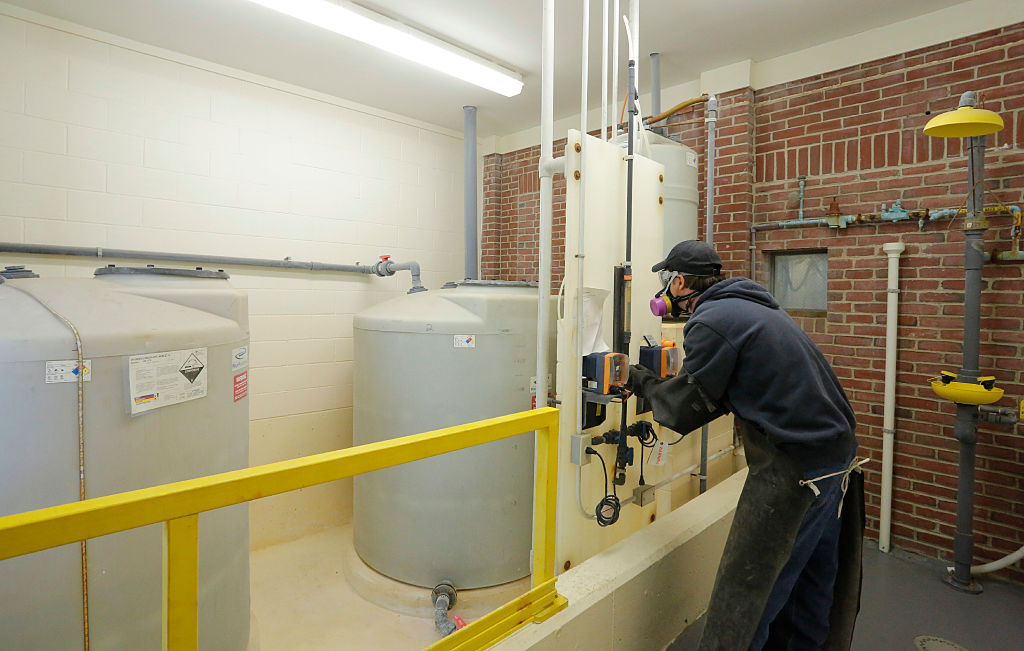It’s been 60 years since Stanley Kubrick’s Dr. Strangelove satirized fears about water fluoridation. But an insistent minority within the scientific community that has questioned its safety is getting renewed attention, raising concerns about whether fluoridation has outlived its purpose.
Earlier this year, fluoridation had its day in court—and lost, to fluoridation skeptics. A judge found that at current suggested levels, fluoride in drinking water “poses an unreasonable risk of reduced IQ in children” and ordered the Environmental Protection Agency (EPA) to “engage with a regulatory response.” The ruling was based in part on a long-awaited review by the National Toxicology Program (NTP), which found an association between high levels of fluoride exposure and cognitive neurodevelopment.
Meanwhile, Robert F. Kennedy Jr., whom President-elect Donald Trump on Thursday nominated to head the Department of Health and Human Services, has claimed fluoride is “an industrial waste associated with arthritis, bone fractures, bone cancer, IQ loss, neurodevelopmental disorders, and thyroid disease,” and has promised to advise the new administration to halt water fluoridation. How did we get here?
Twenty-five years ago, the U.S. Centers for Disease Control and Prevention (CDC) named fluoridation of drinking water one of the 10 great U.S. public health achievements of the last century, along with motor vehicle safety and vaccination. But even among scientists, some people have always looked skeptically at the addition of fluoride to drinking water, said Dr. Margherita Fontana, a professor at the University of Michigan School of Dentistry and director of its Global Initiatives Program in Oral and Craniofacial Health. She agrees with the scientific consensus supporting fluoridation. But, she told The Dispatch, the possible harms of fluoride “has been a very, very hot topic for a very long time. We want to make sure that we’re doing it safely.”
The history of fluoride in drinking water.
Fluoride is one of the most common elements in nature. When present in drinking water, fluoride has both protective qualities against tooth decay and a tendency to cause fluorosis, or staining of the teeth at high concentrations, both of which were discovered in the early half of the 20th century.
In 1944, the City Commission of Grand Rapids, Michigan, along with the National Institutes of Health (NIH) and other state and federal public health organizations, were confident enough in their understanding of fluoride’s risks and benefits to make Grand Rapids the first city in the world to fluoridate its drinking water. Eleven years after fluoride’s 1945 introduction, the results were unequivocal: Tooth decay among children born in Grand Rapids after 1945 had dropped by more than 60 percent.
Its mechanism wasn’t understood then, but we now know that fluoride repairs enamel and reverses tooth decay by boosting the restorative action of saliva. When the carbohydrates we eat and drink are metabolized by microorganisms in the mouth, acids are produced that remove calcium and phosphorus from tooth enamel, making it prone to decay. Saliva helps replace these minerals, but it can’t keep up with our carbohydrate-rich diets. Fluoride excels at re-mineralizing tooth enamel. “Just a very tiny bit of fluoride in the water has this preventive effect,” said Fontana.
How much fluoride is the right amount?
Today, over 72 percent of the U.S. population on community water systems receives fluoridated water, according to the CDC. But adding fluoride to public water sources isn’t federally mandated; it’s up to state and local governments to decide whether to fluoridate water supplies. (If you draw water from a community water supply, you can check your fluoridation levels here.)
Fluoride is added using sodium fluoride, sodium fluorosilicate, or fluorosilicic acid, from which the first two are derived. This fluoride is not industrial waste, as Kennedy described it, but it is industrial-grade—as are all of the more than 40 chemicals used by U.S. water utilities, according to the Indiana Department of Health, all of which must meet federal and industry safety standards.
“Like anything else in public health,” said Fontana, “the dose makes the drug.” Two federal agencies provide guidance on the dose of fluoride in drinking water. On the benefit side, the U.S. Public Health Service recommends an optimal level of 0.7 milligrams per liter (mg/L). That amount is equal to 3 drops of fluoride in a 55-gallon barrel of water. On the risk side, the EPA sets a maximum limit, enforceable by law, on fluoride of 4.0 mg/L.
Fluoridation is an extremely cost-effective public health intervention, reducing cavities by nearly 25 percent in both children and adults, according to the American Dental Association (ADA). The CDC and ADA estimate that the average return on investment is $20 to $38 for every $1 spent by communities on fluoridation, and it saves $32 per person a year, on average, in dental treatment costs.
New sources of fluoride have become widely available.
Still, some scientists are concerned that Americans’ fluoride exposure has increased over time. Fluoridated toothpaste is much more effective today than it was decades ago, said Fontana. It is present in other products, such as mouthwash, and is routinely provided by dentists in varnishes and other applications. Cochrane, a respected research organization, found that the benefits of fluoridation “may be smaller than they were before the widespread addition of fluoride to toothpaste.” With fluoride so widely available, is it still necessary to add it to drinking water? Are we getting too much fluoride—and poisoning ourselves?
A 2016 article in Harvard Public Health suggested that fluoride levels be reconsidered, given new sources of fluoride. However, the article was vigorously supported and rejected by its highly informed readership. That same year, the National Toxicology Program (NTP), part of the NIH, began a systematic study of all relevant scientific literature “to evaluate the extent and quality of the evidence linking fluoride exposure to neurodevelopmental and cognitive effects in humans.” The study, just released in August, found with moderate confidence that fluoride exposure at levels higher than 1.5 mg/L “are consistently associated with lower IQ in children,” and that “more studies are needed to fully understand the potential for lower fluoride exposure to affect children’s IQ.”
The study’s long and by many accounts contentious journey to completion failed to impress much of the scientific community, while it gave more fuel to fluoride skeptics who scientists believe misunderstood it.
Andrew A. Rooney, the acting chief of the Integrative Health Assessments Branch at the National Institute of Environmental Health Sciences and a collaborator on the NTP report, pointed out in an email to The Dispatch that total fluoride exposure can exceed levels currently contained in drinking water, and that about 3 million people in the U.S. have water that naturally contains fluoride at levels higher than 1.5 mg/L. He also said that while the NTP report gives important safety information to regulatory agencies, “it does not assess the benefits of fluoride for improving oral and dental health,” nor does it “address whether the low fluoride level of 0.7 mg/L currently recommended for U.S. community water supplies has a negative effect on children’s IQ.”
Fontana doesn’t put much stock in the NTP report. Not only are exposure levels of 1.5 mg/L more than twice the level recommended by the CDC, she says, but also the study found only an association—not a causal link—to lower IQs in children, nor did it identify a mechanism or theory for how fluoride would cause such a decrease. Moreover, the NTP was only moderately confident in the underlying research, whose data, she details, have a host of problems. “It doesn’t raise any concerns” about the safety of current fluoridation levels, she said. “There’s nothing with the body of evidence that fluoride has.”
When it comes to tinkering with drinking water, such assurances may not be enough for some communities. Two Canadian cities—Calgary, Alberta, and Windsor, Ontario—opted to stop fluoridating drinking water in the last decade and a half. Tooth decay in children rose in both cities, and in Calgary, children in poorer areas were reportedly more adversely affected. “It’s very debilitating,” said Fontana, “because it affects how children sleep, how they eat. There’s pain and infection. In many cases, these kids have to be treated under sedation or even general anesthesia, which no one wants. There’s a huge cost to the family and to society” in removing fluoridation from drinking water.
What about the many European countries that no longer fluoridate their drinking water–but have seen the same reductions in childhood tooth decay as we’ve achieved in the U.S.? Fontana advises looking more carefully. Many of these countries have generous public health programs that address dental health at low to no cost, she says (many also add fluoride to table salt and milk).
Fontana believes public health decisions must take the entire population–what they’re capable of, what’s available to them–into account. As the above-mentioned Cochrane study concluded, the decision to fluoridate should be made “in the broader context of a population’s oral health, diet and consumption of tap water … and the availability and uptake of other caries-prevention strategies.” It would be hard but not impossible for Kennedy to conduct this particular public health experiment. If he succeeds, we and our kids may pay through the teeth for it.









Please note that we at The Dispatch hold ourselves, our work, and our commenters to a higher standard than other places on the internet. We welcome comments that foster genuine debate or discussion—including comments critical of us or our work—but responses that include ad hominem attacks on fellow Dispatch members or are intended to stoke fear and anger may be moderated.
With your membership, you only have the ability to comment on The Morning Dispatch articles. Consider upgrading to join the conversation everywhere.